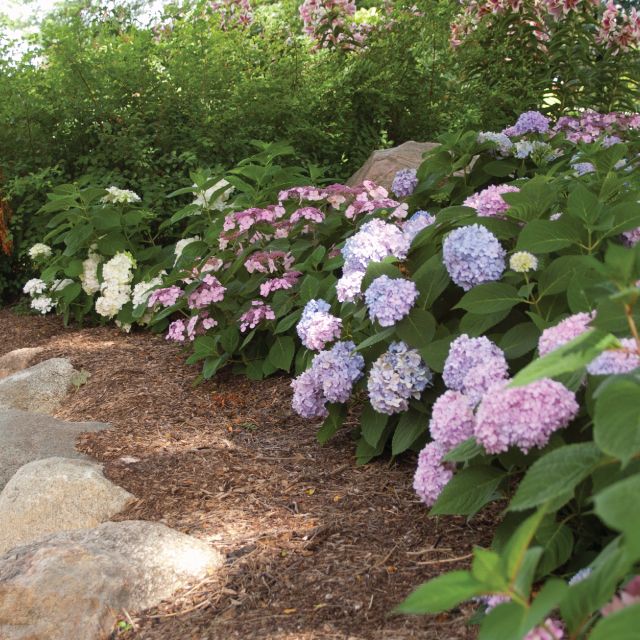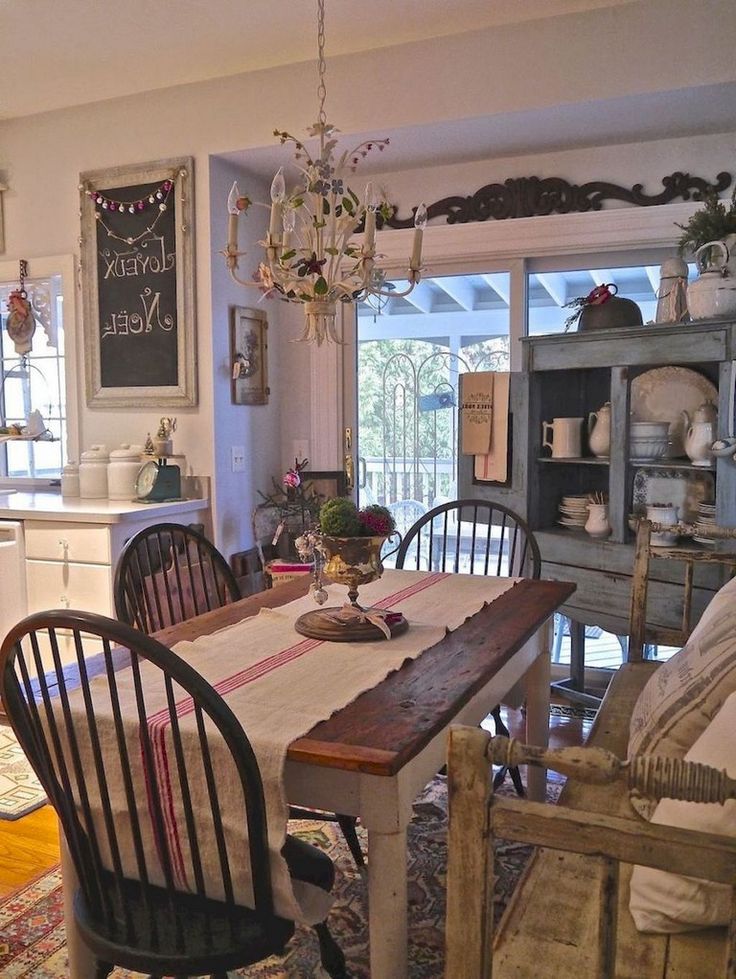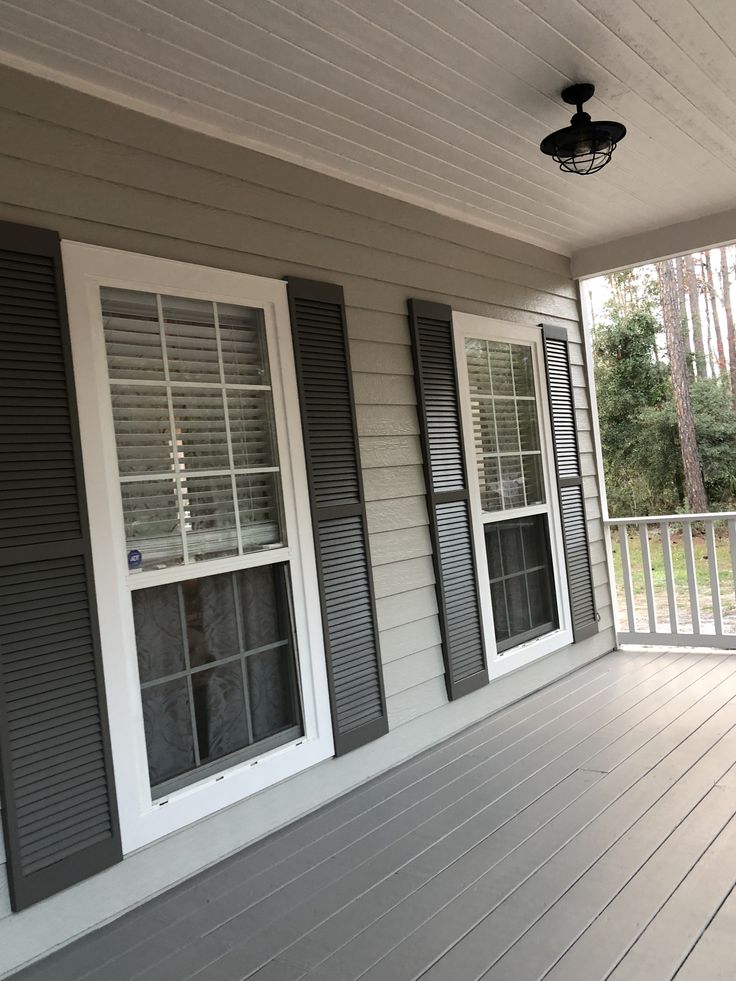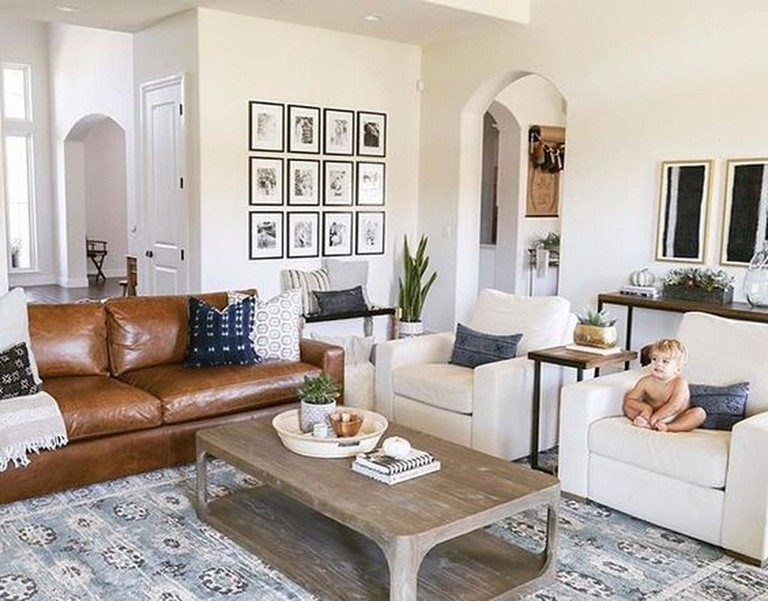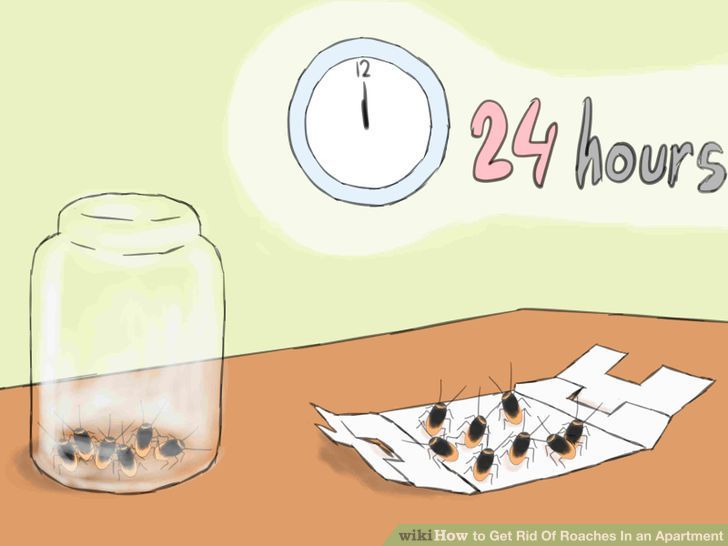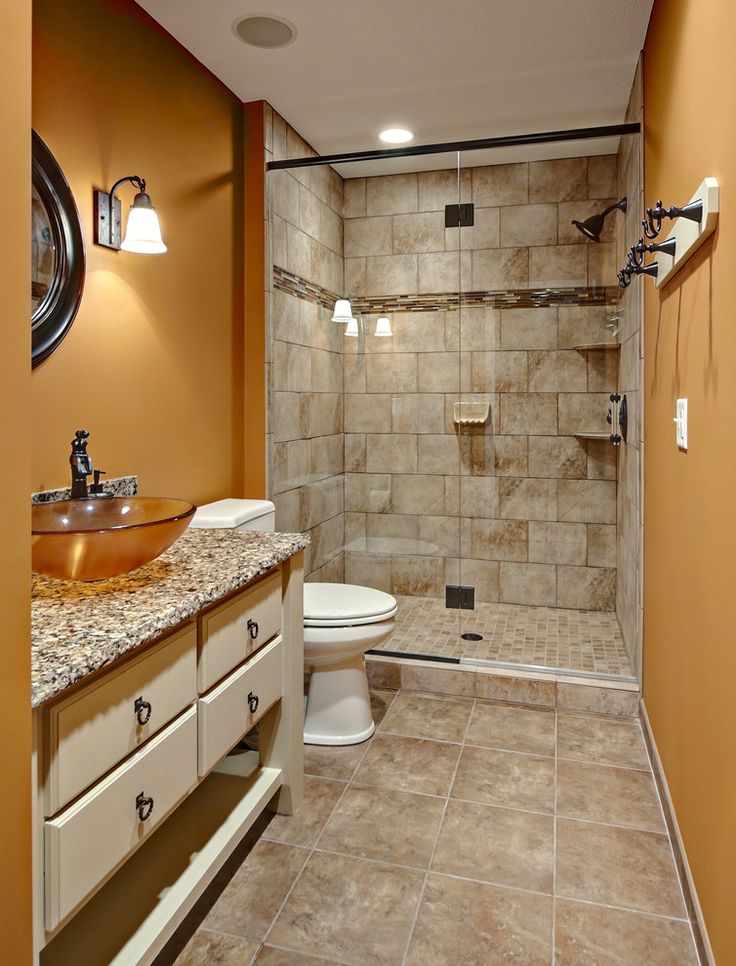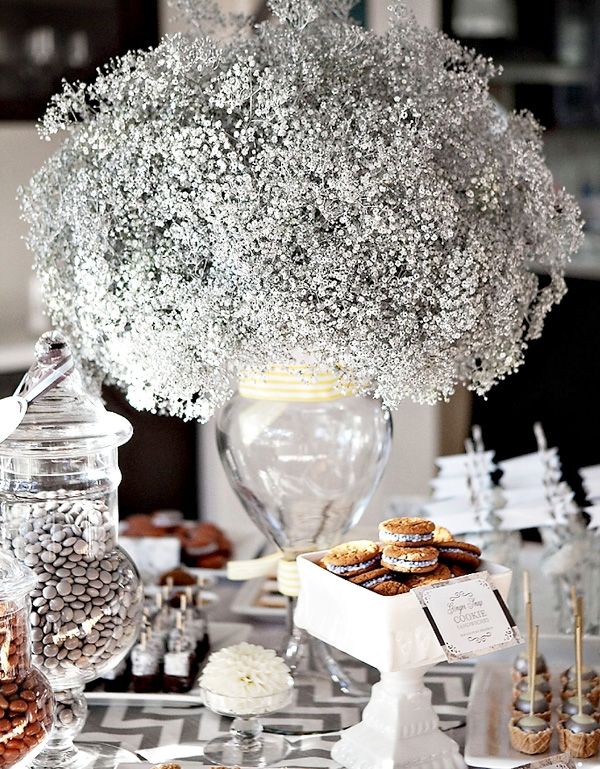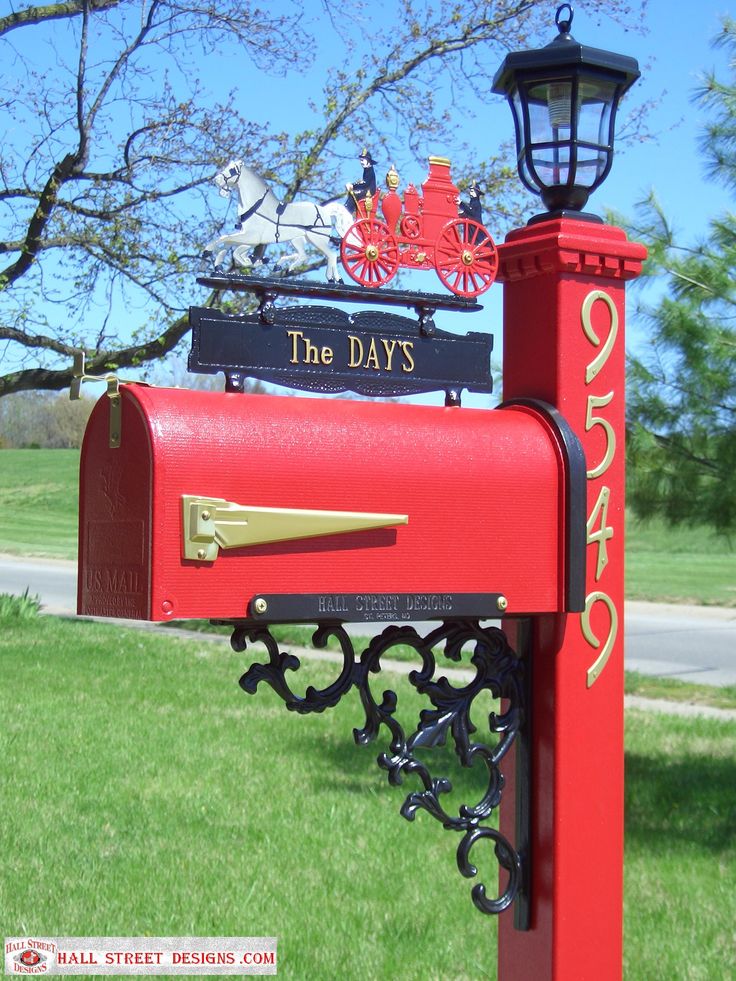Companion plants for hydrangeas
11 Hydrangea Companion Plants (& What Not To Plant With Them)
For summer flower power, hydrangeas are a must. They fill up hard to plant places, producing colorful mopheads of flowers in blues, pinks, pure white, lavender and rose.
When the flowers start to fade, they can change color too. This makes them interesting in the garden, and perfect for flower arranging.
While hydrangeas typically look best when planted en masse on their own, there are a few plants that make great friends for your favorite cut flowers.
Quick Care Guide For Hydrangeas
Hydrangea macrophylla – also known as mophead, bigleaf hydrangeas, or the old-fashioned hortensia – are generally easy to grow and care for with a little knowledge and observation. They also grow well in containers.
These are woody deciduous shrubs like cool, slightly shaded conditions in the dappled shadow of trees or larger shrubs. Avoid too much shade if you want them to bloom well.
They need rich soil with plenty of compost and leaf mold added. Hydrangeas like well-draining soil, but it should be kept moist, especially during the heat of summer. A layer of mulch will help to keep the soil cool and moist.
Hydrangeas need plenty of water and are greedy feeders. They require regular applications of general fertilizer or specialized hydrangea food from spring to fall to perform their best.
Why Do Some Hydrangeas Change Flower Color?
It can be confusing to see your prized blue hydrangea change color to pink once you get them in the ground.
The reason for this is the chemical composition and pH levels in the soil. Flowers are naturally pink, but will turn blue if the soil contains aluminum and the pH is acidic.
In alkaline soils, hydrangeas remain pink and the white ones usually stay white, but may get some coloration in the center of the blooms.
Blue hydrangeas can be kept blue by keeping an eye on the pH levels and adjusting if necessary, or using a commercial fertilizer like Blue Hydrangea Food that is specifically made for that purpose.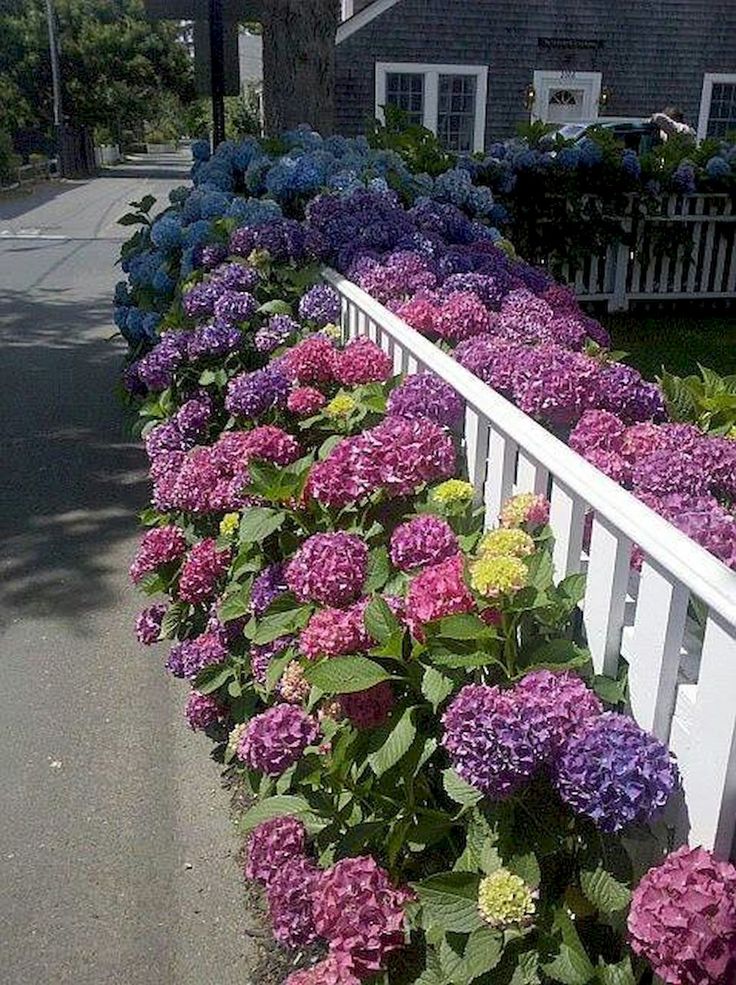
Best Companion Plants For Hydrangeas
1. Azaleas
Azaleas and rhododendrons are some of the best plants to grow next to hydrangeas as they like the same things – a bit of shade and a good organic mulch.
These plants match blue hydrangea’s preference for slightly acidic soil too. Avoid the pink ones, or allow them to turn blue, as they will not do well with acid-loving azaleas and prefer more alkaline soil.
Azaleas are not bothered by insects or diseases, making good companions for any acid-loving plants. For a spectacular show, try the white or yellow-flowering types to contrast with blue hydrangeas. Any of the pink or salmon colors will go well with white hydrangeas.
Most azaleas will flower in spring and into summer, but some varieties will flower at other times of the year to maintain interest in the garden.
2. Heuchera
This perennial plant is known for its striking foliage in shades of purple, red, lime green, rose, gold and green.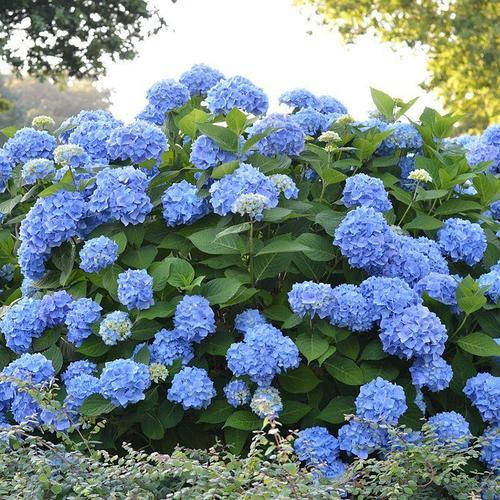
Known as Coral Bells, these plants are native to North America and are perfect for a shaded woodland environment, making them ideal for planting with hydrangeas.
They produce tiny bell-shaped flowers in spring and summer that are rich in nectar and attract pollinators like butterflies and birds in droves.
Plant as a border in front of hydrangeas and choose combos that please the eye when hydrangeas are in flower. One of the classic combos are white hydrangeas with lime green Coral Bells, but there are plenty of options to choose from with this versatile plant.
3. Sweet Potato Vine
Another leafy plant to choose from is the sweet potato vine (Ipomoea batatas).
Although they prefer full sun, they will do with a little shade and form masses of amazing colorful leaves from gold, bronze, brown and nearly black to bright green. The compact size is perfect for planting in front of hydrangeas as a border plant or groundcover.
There are hydrangea varieties across the spectrum for USDA zones 5-11, but sweet potato vine grows best in zones 8-11, so that should be taken into account before planting.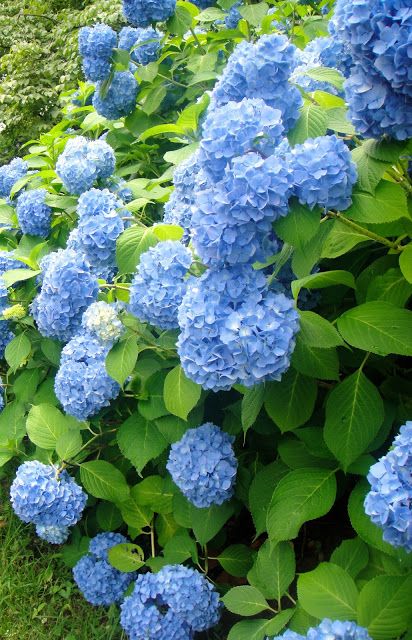
These plants are usually grown as an annual and they love the heat of summer.
4. Hostas
Hostas are another plant that goes particularly well with hydrangeas as they like the same conditions.
They do best in partial shade and some varieties will even grow in deep shade. They also like slightly acidic soil that is rich in nutrients. These plants are at their best in summer, complementing the hydrangea blooms perfectly.
There are many different sizes (1-3 feet tall) and colors to choose from, including variegated varieties in shades of green, lime-green, blue-green and white. Plant as a border with hydrangeas for a big-leafed bonanza.
Related Reading: 29 Hosta Varieties To Plant In Your Shade Garden
5. Swedish Ivy
Often grown as a houseplant, this plectranthus is an excellent groundcover to fill space between plants, or as a border plant in front of hydrangeas to keep the soil cool and moist. It has small shiny, dark green round leaves that cover well and grow in warm areas with dappled shade.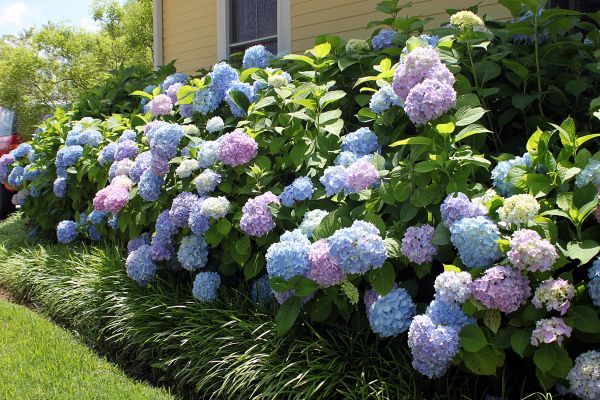
Plectanthus verticillatus will bloom almost all year round with small, pretty white flowers on spikes around 8 inches tall. It grows easily from cuttings and likes the same conditions as hydrangeas.
6. Ferns
Many types of small ferns are perfect for growing next to hydrangeas. Their lacy leaf structure is a good contrast to the large leaves of hydrangeas, making for an interesting combination.
Ferns like rich moist soil and shady conditions, much like hydrangeas. There are ferns that like acidic soil and some that like alkaline soil, so there are plenty of species to choose from for both pink and blue hydrangeas.
There are also ferns for all hydrangea planting zones. Be sure to choose the right species before planting.
7. Boxwood
The combination of clipped boxwood hedging and the wilder look of hydrangeas provides great contrast, especially in formal gardens. Boxwood can also be clipped into rounds that make for an appealing design, planted between hydrangeas with the shape of the flowers mimicking the rounds for symmetry.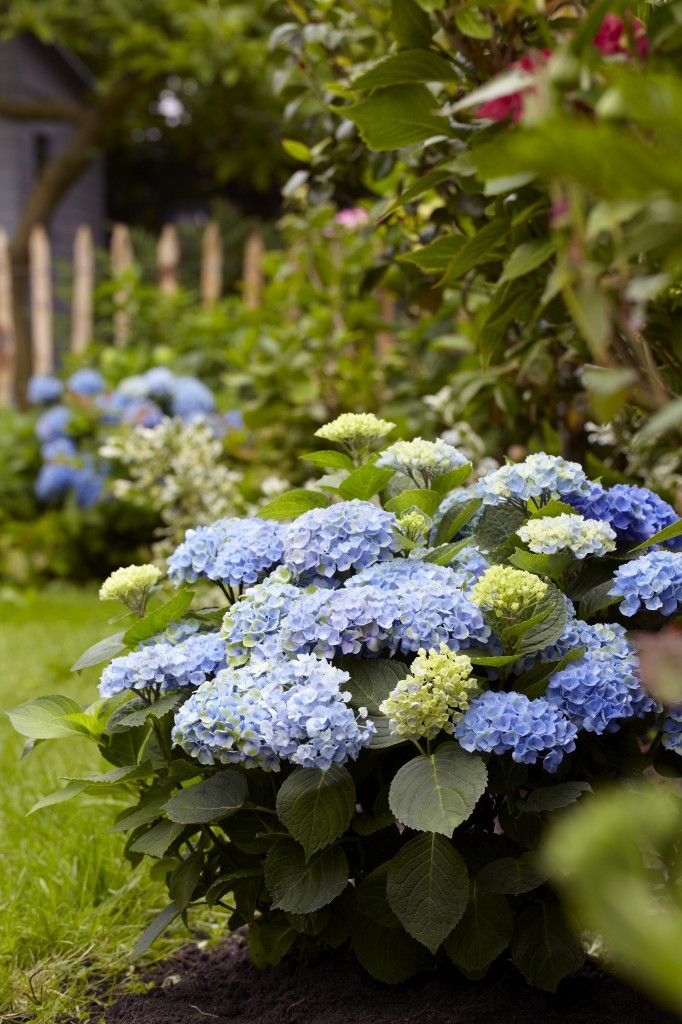
The plant is Buxus sempervirens, also known as Common or American Boxwood, and has the same requirements as hydrangeas.
They prefer a bit of afternoon shade and protection from the heat of the day. Boxwoods also prefer organic soil with a good mulch to help keep moisture in. Their watering needs are the same as hydrangeas too.
Boxwood shows off hydrangeas well and can be planted in front as a low hedge and formal border, or behind as a tall hedge and green backdrop.
8. Ornamental grasses
The thin strappy leaves of ornamental grasses make them appealing companion plants for hydrangeas.
The dark green options are exceptional with white hydrangeas, and the variegated green and cream types go well with white, pink and blue hydrangeas, depending on what you have chosen.
Grasses like Blue fescue (Festuca glauca) have spiky mounded forms that make a good border or edging.
Dwarf Fountain Grass or Dwarf Maiden Grass has dark green foliage that cascades to give movement to a border.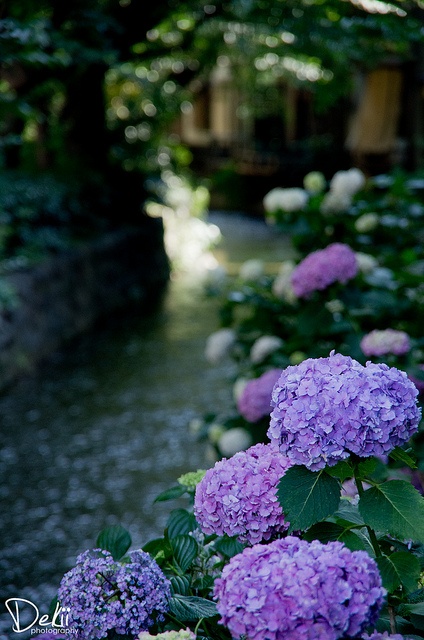
Japanese forest grass (Hakonechloa macra) is a good choice for its form and variegated green and gold foliage.
Many of these grasses do well in shade and partial shade and require regular watering with hydrangeas.
9. Astilbe chinensis
Dazzling is the only word to describe Astilbe chinensis. They also like the same conditions as hydrangeas do, growing best in wet and shady areas.
The combination of hydrangea flowers and the bright feathery plumes of astilbes in a range of either pink, purple-red and white is attractive in any garden.
Astilbes are also easy to grow and maintain, only requiring regular watering and good drainage. They are also pollinator magnets and are deer and rabbit resistant.
Astilbe chinensis blooms in spring and summer, flowering when hydrangeas do to make a spectacular display. They will not flower as much in deep shade, and can get scorched in full sun, but do well in dappled shade with hydrangeas.
10.
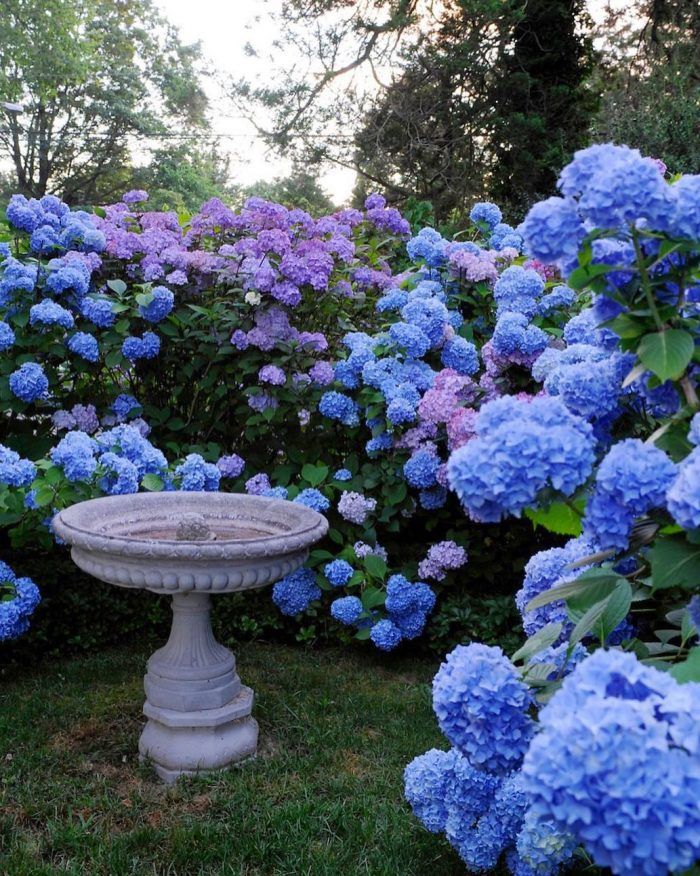 Japanese Pittosporum
Japanese PittosporumThese evergreen shrubs grow well in sun or light shade, used for multiple purposes including hedging, grouped on borders, or for edging and trimmed to keep low.
This versatile plant is tolerant of a lot of conditions, but prefers those similar to hydrangeas. The leaves are set in whorls in dark green or variegated green and white that make attractive forms in the garden.
Pittosporum tobira does best in the higher zones between 8 and 11. Like hydrangeas, pittosporum does not do well if there is poor drainage.
11. Veronica Speedwell
Masses of Veronica speedwell (Veronica officinalis) planted in front of hydrangeas is a beautiful sight when they flower in colors ranging from blue, pink and white in spring right through to autumn.
These hardy perennials grow in a range of conditions from full sun to partial shade and in any soil. The pH of the soil can be alkaline, neutral, or acidic, perfect for pink or blue hydrangeas.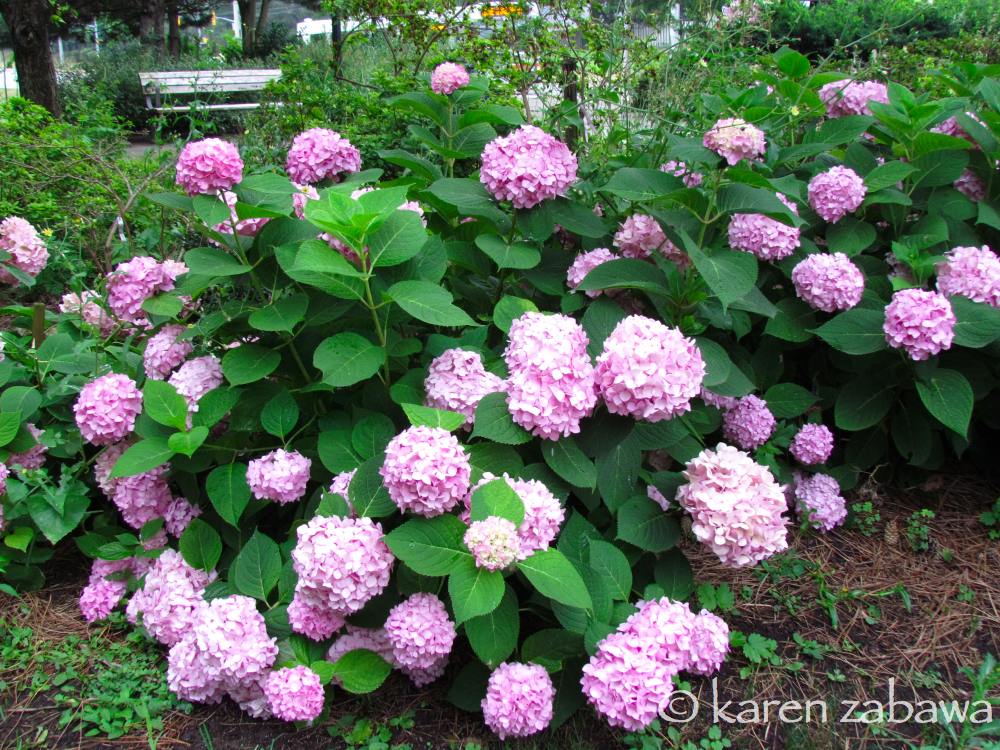 They are also happy with the high moisture content needed for hydrangeas.
They are also happy with the high moisture content needed for hydrangeas.
The only thing they require is well-draining soil. Veronica speedwell produces flower spikes 1-3 feet tall and will do best in zones 3 – 8.
What Not To Plant With Hydrangeas
Due to the conditions hydrangeas prefer, sun-loving or deep shade plants will not cope. Many ornamental and edible plants fall under this list, making poor companions.
Similarly, plants that prefer dry or poor quality soil, such as lavenders, will not grow well with hydrangeas, no matter how pretty the flowers look together.
Luckily, there is equally a long list of plants that can be planted with them and make for spectacular combos in the garden.
Read Next: How To Propagate Hydrangeas From Cuttings
What to plant with hydrangeas: 10 beautiful companion plants
(Image credit: Getty Images)
When deciding what to plant with hydrangeas, consider not just varieties that will complement the plants visually, but those that will thrive in the same growing environment.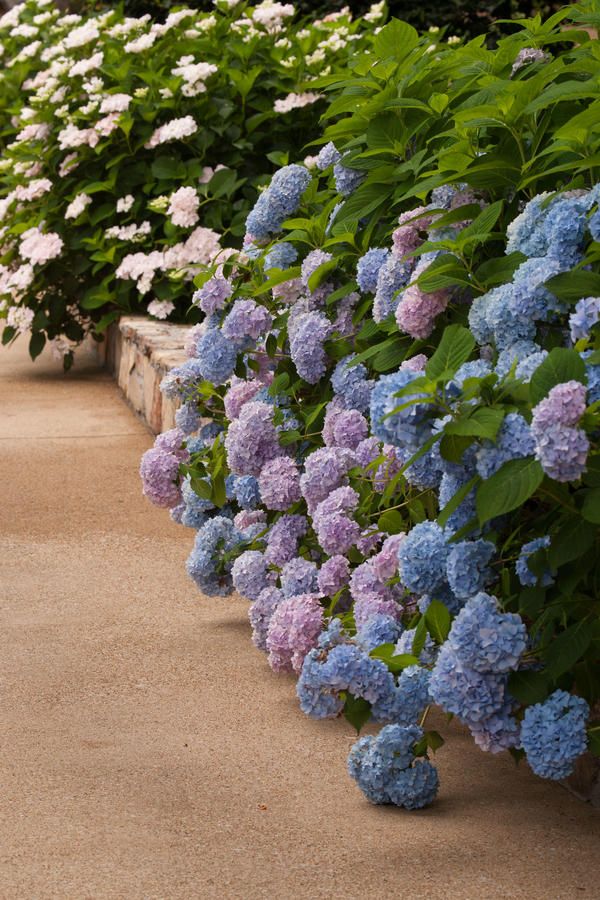
Knowing how to successfully mix different plants is an important part of learning how to grow hydrangeas. And, of course, companion planting, can be beneficial for every plant in the mix.
'Hydrangeas have an easy sort of elegance. Their bold yet simple blooms make them the perfect companion for an exciting range of plants in the landscape,’ says Kip McConnell, director of Southern Living Plant Collection .
‘When choosing companion plants for hydrangeas, think about maximizing color and extending bloom time in your garden. With the right pairings, hydrangeas can help you do just that – they can amplify a color palette and provide months of beauty before passing on the "baton" to their companion plant.’
What to plant with hydrangeas – best varieties
‘The best companion plants for hydrangeas depend on your type of hydrangea, where you grow it (warm or cold zones), how you site it (south facing, east facing, etc), and the color of the flowers,’ says Lorraine Ballato, author of Success With Hydrangeas .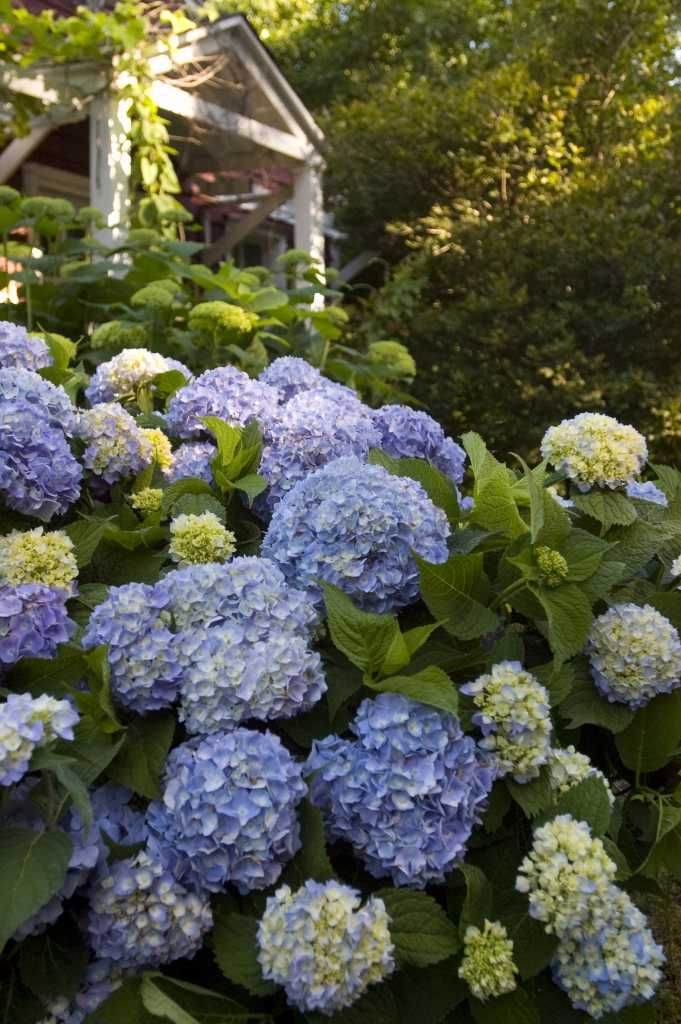
Hydrangeas grow best in moist, well-draining soil, and will thrive in both acidic or alkaline soil. It’s important to know what soil type you have, so when considering what to plant with hydrangeas, you can choose other varieties to suit.
Interestingly, the flowers of some types of hydrangea will change depending on the soil pH – blue for acidic and pink for alkaline.
You should also bear in mind that most hydrangeas prefer some shade, and can struggle in full sun.
Knowing how to prune hydrangeas will also ensure you are able to get the best out of them.
1. Hostas
(Image credit: Getty Images)
‘Hostas are a great companion plant for hydrangeas,’ says Julia Omelchenko, a botanist expert for the NatureID app .
‘These small bushes feature drop-shaped leaves with bright margins that highlight the plain greenery and pastel-colored inflorescences of hydrangeas.’
Hostas thrive in nutrient-rich, moist – but not waterlogged – soils, preferring slightly acidic growing mediums.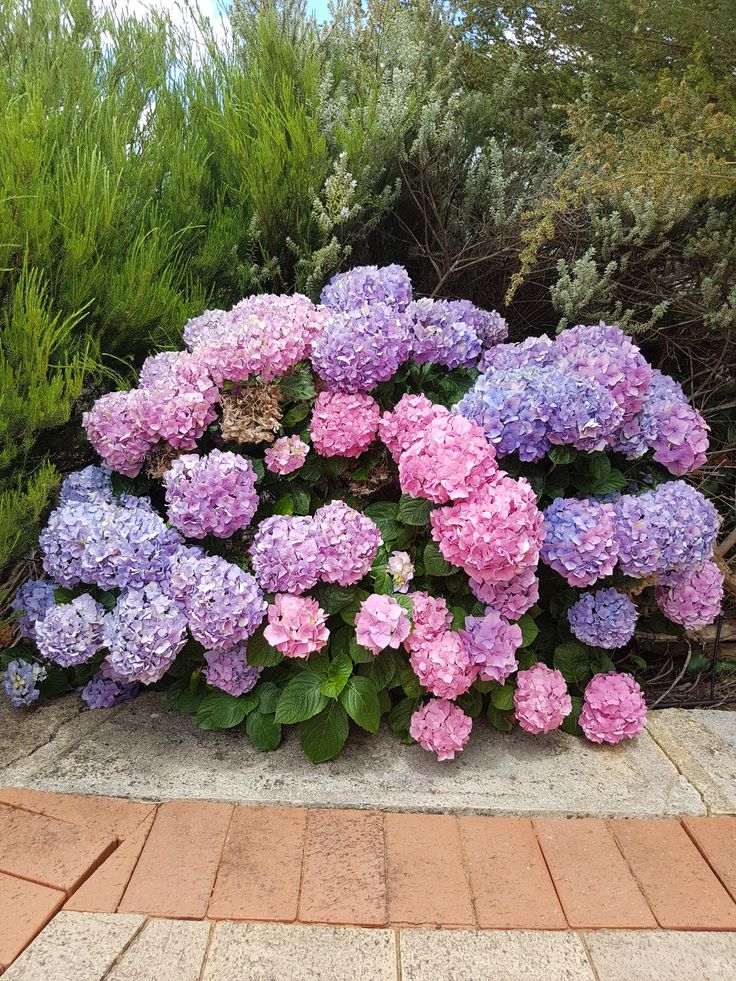 Like hydrangeas, they prefer partial shade
Like hydrangeas, they prefer partial shade
‘I recommend growing hostas in flower beds and using them in multi-level garden compositions,’ adds Omelchenko.
2. Daylilies
(Image credit: Getty Images)
When considering what to plant with hydrangeas, think about classic color combinations.
‘If you have a big leaf hydrangea with big blue or pink flowers, try daylilies in contrasting colors like orange – it's a classic Van Gogh color scheme,’ says Ballato.
Daylilies are striking perennials with exotic-looking lily-like flowers. Though they may appear delicate, they are surprisingly hardy and easy to grow, and will thrive in most soil types.
‘The trouble-free daylilies can take the part shade needs of the hydrangea and still produce great flowers,’ adds Ballato.
As well as orange, daylilies come in other colors, ranging from pure white to deepest red.
3. Gardenia
(Image credit: Getty Images)
‘I love the cloud-like blooms of a white hydrangea paired with the fragrant white blossoms of gardenia,’ says McConnell.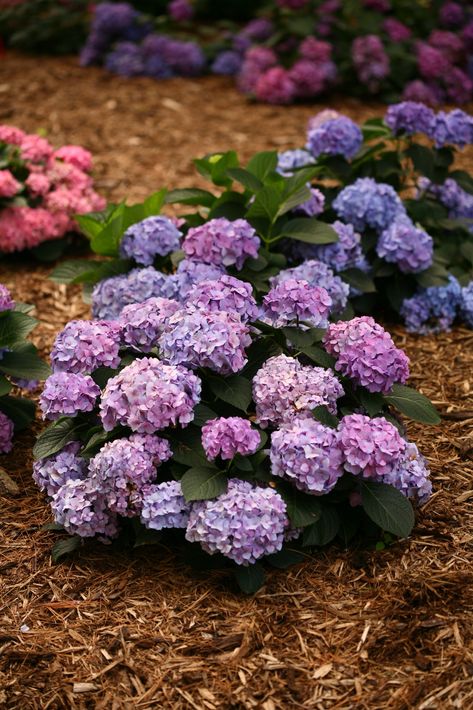
‘The large, sculpted leaves of hydrangea meld seamlessly with the deep green foliage of gardenia, creating the perfect backdrop upon which the plants’ white blossoms pop.’
McConnell particularly recommends the 'Diamond Spire' gardenia, which produces fragrant, single white blossoms late spring through fall with an upright habit.
However, bear in mind gardenia will only thrive outdoors in warmer climes – there are varieties suitable for USDA zones 7a-10b – otherwise they can only be grown indoors.
‘Gardenias enjoy plenty of moisture; to maximize their glorious blossoms, feed them by applying an acidic, slow-release fertilizer such as an azalea or camellia fertilizer,’ adds McConnell.
4. Echinacea purpurea
(Image credit: Getty Images)
‘Echinacea purpurea blooms around the same time as hydrangeas and adds a pop of color. It is a great plant to include in the foreground of your hydrangeas,’ says Sam Hoadley, manager of horticultural research at Mt.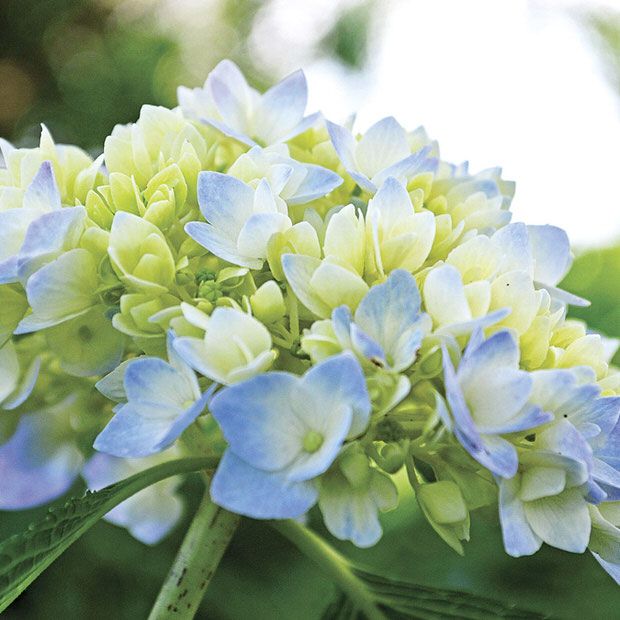 Cuba Center botanical gardens.
Cuba Center botanical gardens.
Tolerant of partial shade, echinacea purpurea grows well in moist fertile soils where hydrangeas thrive – as long as it is well draining – and can be planted in acidic or alkaline soil.
‘As an added bonus, this species is also known to attract a large number of insect pollinators,’ adds Hoadley.
5. Pieris japonica
(Image credit: Getty Images)
Flowering early in the season, pieris japonica is a great companion plant for hydrangeas. ‘This spring-blooming shrub partners well in a shrub border with hydrangeas; I consider it the opening act for the summertime hydrangea display, says Bob Polomski, horticulturist with Clemson University Cooperative Extension .
‘This evergreen prefers acidic soils and is a suitable companion for hydrangeas that produce blue flowers at a soil pH of 5.5 or less.’
As with hydrangeas, pieris japonica needs a partially shaded, sheltered spot.
6. Conifers
(Image credit: Leigh Clapp)
When thinking about what to plant with hydrangeas, don't overlook trees and bushes.
‘Conifers – thujas, junipers, pines, and dwarf pines – are some of the best companion plants for hydrangeas,’ says Omelchenko.
She recommends creating various elegant compositions by combining tall thujas and spreading hydrangea bushes. 'It’s better to grow these plants on two levels – high trees in the background and lower bushes in front of them.
‘This design isn’t only beautiful but also beneficial for hydrangeas – thujas give them the necessary shade.’
Conifers are a broad species, but generally they prefer acidic, well-draining soil. As evergreen plants, they add color and interest to the garden year round, including in winter. When the cold weather arrives, make sure you know how to winterize hydrangeas to protect them from the elements – and to show them off against the conifers.
7. Ornamental grasses
(Image credit: Getty Images)
Ornamental grasses add a wonderfully textural contrast to hydrangeas. Many species are non-invasive, and will happily fill a border, nestling in around other plants.
‘If your hydrangea has a white flower, try some black mondo grass. The contrasting color which it holds all season long marries well with the hydrangea and grows happily in similar conditions,’ says Ballato.
‘Another very popular companion plant is Japanese forest grass. Like the mondo grass, it holds its golden color all season long and enjoys the same growing conditions as the hydrangea.’
8. Camellias
(Image credit: Getty Images)
‘Some hydrangeas, such as "Heart Throb", provide glorious blooms over three seasons, offering a radiant show when the weather is on the warmer side. But what about winter? A clever pairing of camellia offers blooms that pick up where hydrangeas leave off, ensuring your garden has almost year-round flowers,’ says McConnell.
'October Magic Ruby' is a lovely recommended variety, with winter blooms and shiny green leaves all year. A compact grower, Ruby is a convenient semi-dwarf but with a soft, romantic appearance.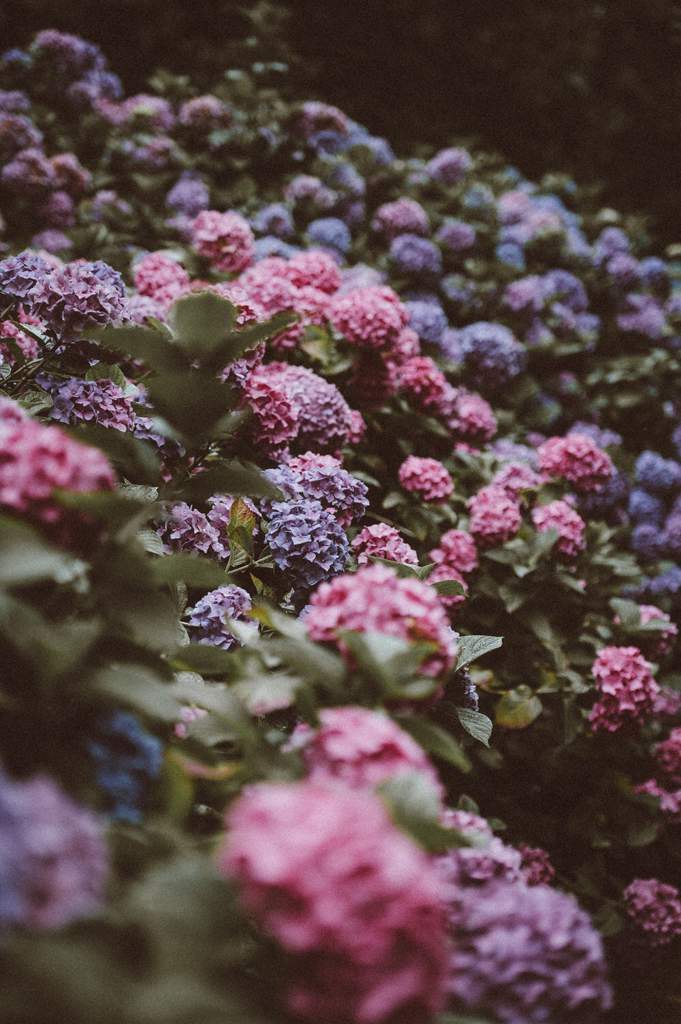 It thrives in full sun to part shade, in USDA Zones 7a-9b
It thrives in full sun to part shade, in USDA Zones 7a-9b
‘Camellias prefer well-drained, acidic soil. The simplest way to provide it is to use a commercial mix for rhododendrons and azaleas or camellias – avoid peat moss, which can dry out quickly and harden,’ adds McConnell.
9. Astilbe
(Image credit: Getty Images)
‘Commonly known as the false goat's beard, astilbe grows well alongside hydrangeas,’ says Omelchenko.
The frothy flowering plant tolerates shade, requires abundant watering, and thrives in acidic growing mediums.
‘Astilbe's appearance is also a good match as it reflects rather than outshines the beauty of hydrangea. With its lush foliage, the false goat's beard keeps its decorative value even after the blooming season is over,’ adds Omelchenko.
‘The plant’s fern-like delicate branches please the eye and look gorgeous against the background of hydrangeas’ round leaves.’
10. Clematis viorna
(Image credit: Alamy)
‘Clematis viorna is a lesser-known native plant species that would be stunning when allowed to climb up Hydrangea arborescens,’ says Hoadley.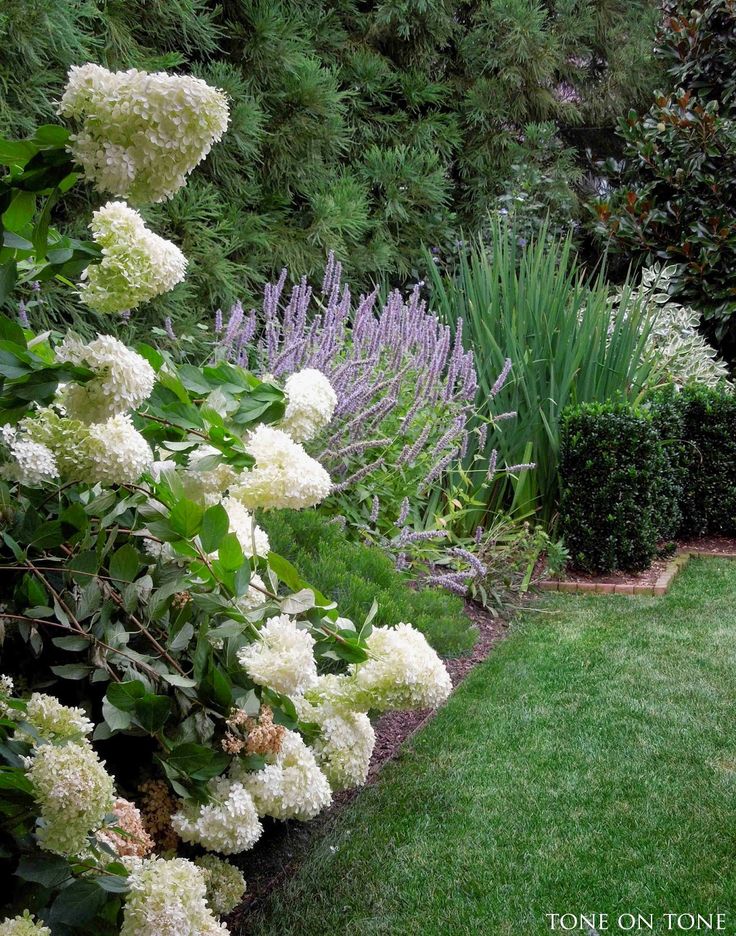
The clematis roots thrive in cool shaded conditions at the base of the hydrangea shrub while their vining top growth is tolerant of part shade to full sun and can gently twine though the hydrangea shrub itself.
‘Their whimsical flowers would offer a pop of color and contrast to the large showy inflorescences of the hydrangeas,’ adds Hoadley.
Planting roses and hydrangeas together
It is possible to plant roses and hydrangeas together. However, as roses are sun loving, while hydrangeas prefer some shade, you will need a more tolerant variety.
Paniculate hydrangea 'Limelight' thrives in full sun, and its limey colored blooms make a perfect foil for romantic pink roses.
Can you plant peonies and hydrangeas together?
As peonies flower earlier in the season than hydrangeas, they can make lovely planting companions. Once they are over, the plant will begin to die back, making way for hydrangeas to shine.
Peonies thrive in full sun or partial shade, and prefer a sheltered spot.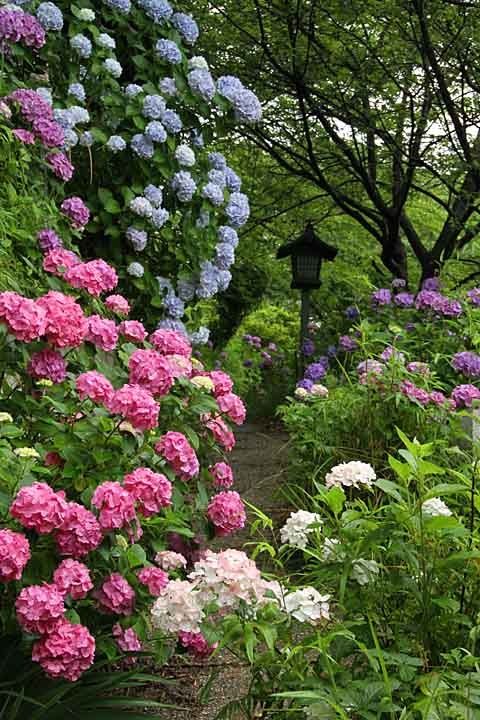 They are also tolerant of most soil types, provided they are free draining.
They are also tolerant of most soil types, provided they are free draining.
As editor of Period Living, Britain's best-selling period homes magazine, Melanie loves the charm of older properties. I live in a rural village just outside the Cotswolds in England, so am lucky to be surrounded by beautiful homes and countryside, where I enjoy exploring. Having worked in the industry for almost two decades, Melanie is interested in all aspects of homes and gardens. Her previous roles include working on Real Homes and Homebuilding & Renovating, and she has also contributed to Gardening Etc. She has an English degree and has also studied interior design. Melanie frequently writes for Homes & Gardens about property restoration and gardening.
What to plant next to a hydrangea to emphasize its beauty
Luxurious hydrangea bushes are self-sufficient on their own, usually even without companions growing nearby, this plant can make any corner of the garden magically beautiful, accentuate the compositional decision of a landscape engineer.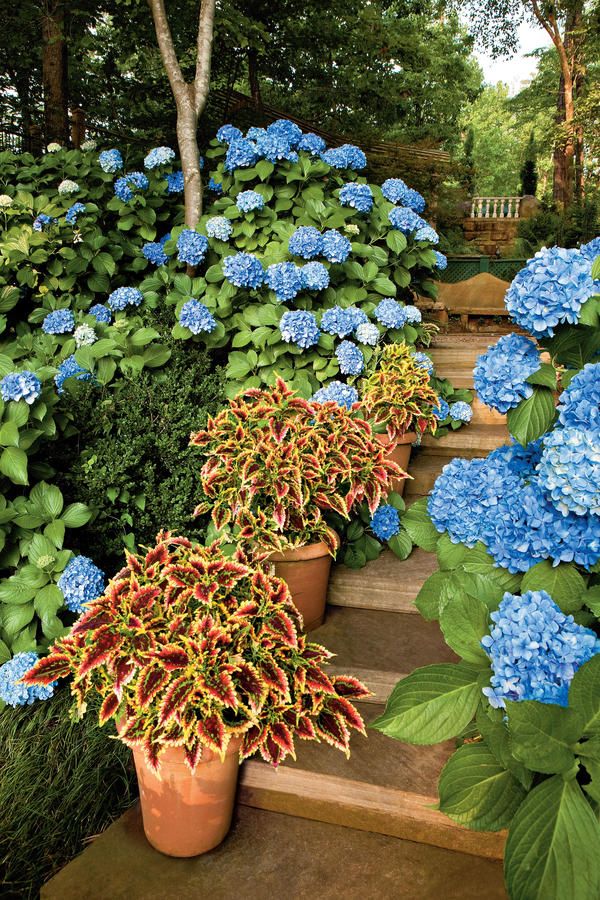
So I thought until I got into one unique garden, where every little thing is thought out, and hydrangeas do not grow by themselves, but are a continuation of the flower arrangement. Everything is interconnected - bunches of colorful herbs, strict and airy; undersized carpet flowers, shading the unsurpassed luxury of hydrangeas. Decorative stones, wood chips, lawn framing, all together create a finished and verified composition that you want to admire. Traditionally, hydrangeas are planted singly or in groups, sometimes they are planted as a hedge, where the hydrangea is the soloist, and other plants emphasize its beauty.
Who can enhance the beauty of hydrangeas
Before choosing companions for hydrangeas, let's remember that this plant needs acidic soils. This means that those companion plants that will be planted next to the queen should have similar soil pH requirements.
If hydrangeas do not grow in a group, but singly, an acidic substrate is added directly to the planting hole, which means that the soil around the plant will remain slightly acidic or neutral, which will significantly expand the range of plants for creating joint compositions.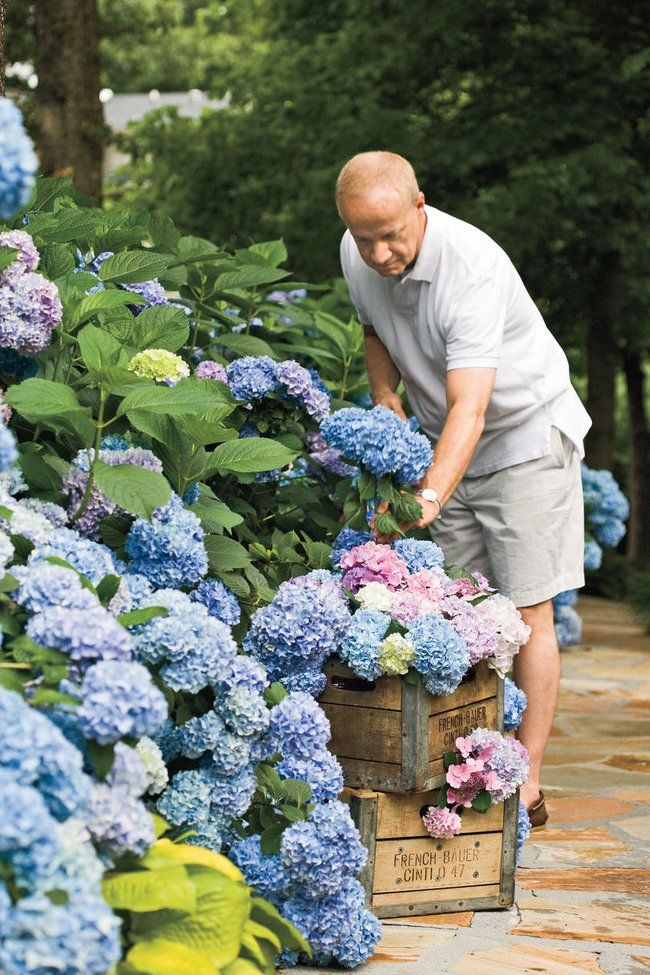
Companions planted next to hydrangeas can solve more than one problem:
- They will add spatial lightness - ornamental grasses will do just fine with this.
- They will create a unique garden corner, designed in the same range - flowering plants, matched to match the hydrangea inflorescences, will effectively complement the composition. Flowers contrasting in color will set off the rare beauty of lush hydrangeas, emphasize their luxury and magnificence. Not sure about choosing the colors of your companion flowers? Choose plants with white flowers - they are harmonious in any composition.
- They will help create an individual landscape, support the style decision in the design of the garden. Hydrangea is a very plastic culture, it fits perfectly into the compositions of any style, so suitable companions can support the solo prima, bring additional lightness and completeness to the design of the landscape.
- They will increase the decorative effect of the composition at a time when hydrangeas have not yet blossomed or have already finished flowering - hydrangeas mostly bloom in summer, finish flowering by early autumn, and look less decorative in early spring and at the time of leaf fall.
 Perennials and herbaceous annuals planted nearby can decorate the composition, adding additional sophistication and completeness to it. Especially often for these purposes, decorative deciduous and flowering plants are used.
Perennials and herbaceous annuals planted nearby can decorate the composition, adding additional sophistication and completeness to it. Especially often for these purposes, decorative deciduous and flowering plants are used.
Let's move from words to deeds - let's consider applicants for the role of hydrangea companions in garden flower beds.
Ferns
One of the best companions for hydrangeas is the garden fern. Its lacy fronds, bent to the ground, seem to be bowing to the beautiful mistress. The fern prefers to grow in partial shade, in this its predilections are similar to hydrangea. The plant also loves high humidity and responds well to frequent watering. The fern winters well, grows quickly in the spring and is able to give the composition tenderness and grace.
Hostas
The variety of hostas will help you choose varieties that will contrast decoratively with the dark foliage of the hydrangea. Hostas thrive in places with low light and high humidity, which is necessary for the successful cultivation of hydrangeas. Choose not too high and dull-monotone varieties for decorating compositions. Stop looking at the variegated compact forms. Such bushes will very quickly turn into a bright living ribbon, and will resemble a motley train on a favorite's dress.
Choose not too high and dull-monotone varieties for decorating compositions. Stop looking at the variegated compact forms. Such bushes will very quickly turn into a bright living ribbon, and will resemble a motley train on a favorite's dress.
Herbaceous perennials
Ivy, periwinkle, bergenia, primrose, daffodils and irises can be planted next to luxurious hostas.
Quivering astilbe, blooming with delicate openwork panicles, looks great against the background of a dense green bush.
Primroses bloom early but stay decorative for a very short time. Their brightly colored caps are able to decorate the hydrangea garden until huge brushes of delicate pastel or bright colors appear on the bushes.
The huge leaves of the bergenia and its graceful pink blooms can attract attention until the hydrangea begins to play the solo part of the annual bloom.
Multi-coloured geyheras thrive next to hydrangea bushes, these plants can be used to decorate very dark areas.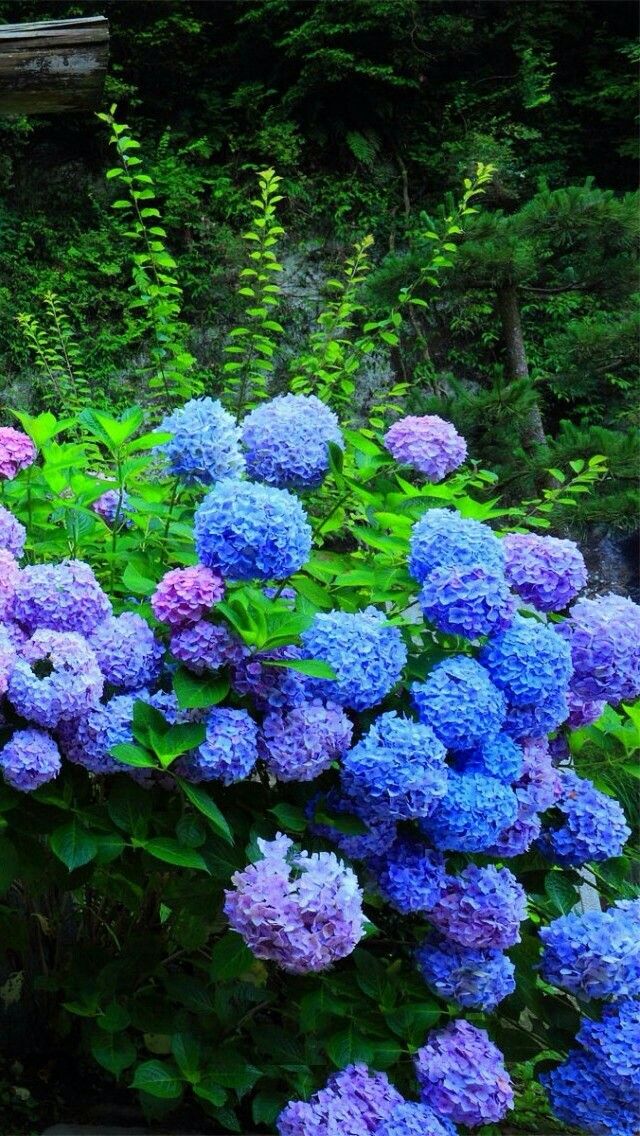
Roses
The queen of the garden at the feet of hydrangeas will look a bit un-royal, but these plants look just fine next to each other. The color of roses is selected to match the hydrangeas or play in contrast. Choose roses of remontant varieties, then in late autumn this composition will look rich, because flowers appear on rose bushes before frost, and lush hydrangeas will serve as a deep monophonic background.
Low-growing roses can be planted as borders.
Perennial Grasses
One of the most popular landscaping trends is the planting of perennial grasses that add lightness and volume to a garden arrangement.
All types of sedges can be used, since breeders have developed many varieties with colored leaves. Fescue, mace, miscanthus, pampas grass - these plants are chosen based on the degree of illumination of the site. Lush hydrangeas next to bunches of light herbs no longer look too massive. Some herbs are not recommended to live in acidic soil, but can be planted in the background or between bushes to avoid unfavorable growing conditions.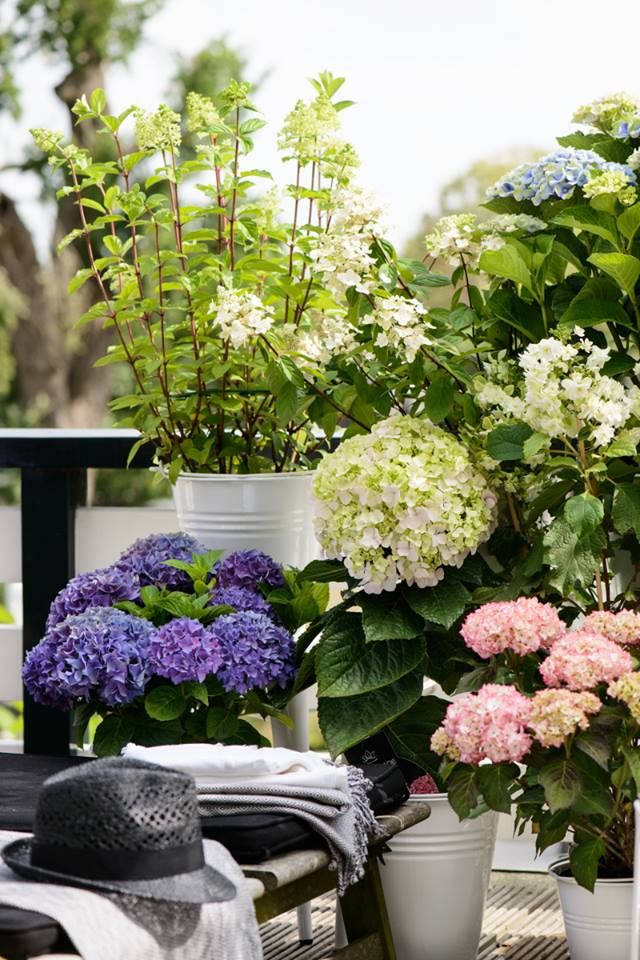
Everyone can create an individual corner of the garden - experiment, do not be afraid and create a worthy frame for your hydrangeas.
Published: 17 Aug 2020
Views: 6198
(Votes: 0, Rating: 0)
Share with friends:
How to plant hydrangea: 5 options with photo
Hydrangea, with its huge inflorescences and beautiful green foliage, is an adornment of any garden on its own, without neighboring plants. However, a properly selected companion can enhance the beauty of the shrub, make it even brighter and more expressive.
What plants would look good next to a hydrangea? There can be many options here, here are just a few examples of successful combinations:
- Look for plants that match the shape of the leaf blades or the color scheme of your hydrangea. For example, if your shrub has rounded leaves, then choose a plant with rounded foliage as a companion. Your hydrangea has purple buds - plant flowers of the same color next to it.
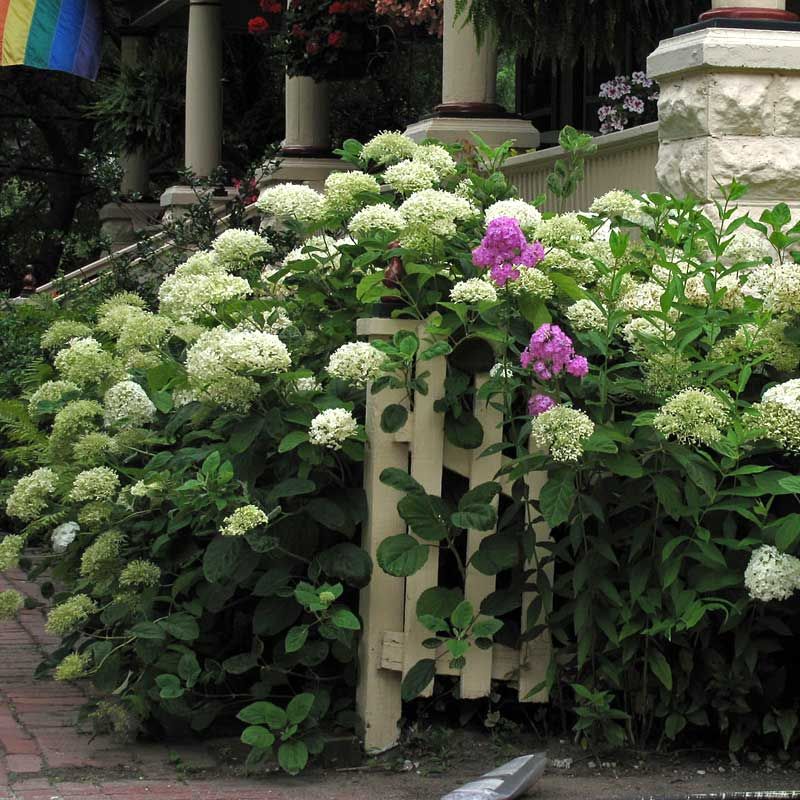
- Select plants that will contrast with the hydrangea. For example, against the background of lace wai ferns, hydrangea with its whole leaves will look advantageous. If you want to "play" on color contrast, then plant a bush of scarlet roses next to a white hydrangea - with such a neighborhood, each of the plants will look even more expressive.
- Quite often, stunted plants are located next to tall hydrangea bushes. In this case, a low neighbor "covers" the bare hydrangea shoots, leaving only beautiful parts of the bush for viewing.
What hydrangea loves
However, it is not enough to choose a flower or bush that will harmonize well with the hydrangea in terms of color, height or volume. The fact is that hydrangeas have very peculiar requirements for the soil, so not every outwardly ideal "partner" will withstand the conditions that this "magnificent beauty" needs. What does hydrangea need for normal development?
- Humidity .
 The name of the hydrangea in Latin sounds like Hydrangea (Hydrangea), which means "water vessel". It is clear that a plant with this name is moisture-loving. For this reason, you should not plant hydrangeas too close to trees, especially near birches, because the latter will draw moisture from the soil, taking it away from the hydrangea.
The name of the hydrangea in Latin sounds like Hydrangea (Hydrangea), which means "water vessel". It is clear that a plant with this name is moisture-loving. For this reason, you should not plant hydrangeas too close to trees, especially near birches, because the latter will draw moisture from the soil, taking it away from the hydrangea. - Penumbra . Hydrangea can, of course, grow in the sun, but the ideal place for it is a place where the sun shines in the morning, and in the afternoon, during the hottest period of the day, the bush is in the shade.
- Fertile soil . Hydrangea will show itself in all its glory and will bloom profusely only on fertile soil.
- Acidic soil . Unlike most plants, hydrangea prefers acidic soil with a pH level of 5-5.5.
Option 1. Hydrangea and conifers
One of the best neighbors for hydrangeas will be conifers: arborvitae, junipers, spruces, dwarf pines, etc.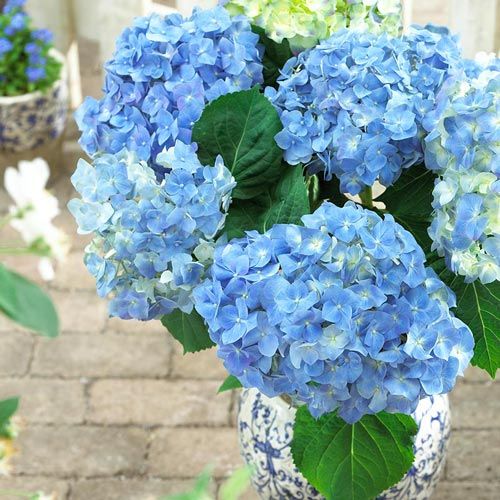
Various combinations of slender arborvitae and sprawling hydrangea bushes look great. They can be planted in two tiers: in the background - high arborvitae, in front - lower hydrangea bushes. In this case, the thuja create the shadow necessary for the hydrangeas.
It is also possible to place the plants in a single row, but do not place the seedlings too close to each other during planting. Plant them at a distance of 1.5-2 m - that is how much space each of their plants needs for normal growth and development in adulthood.
No less interesting is the option where, next to large hydrangea bushes, there are undersized junipers (pictured). With this planting, both plants will feel comfortable, because they equally love acidic soil and easily tolerate partial shade.
Hydrangea paniculata Cotton Cream is characterized by a compact bush up to 1 m in height. If the plant is not pruned, it can grow to over 2 m.
Inflorescences are greenish when blooming, then creamy white, and at the end of flowering they turn pinkish.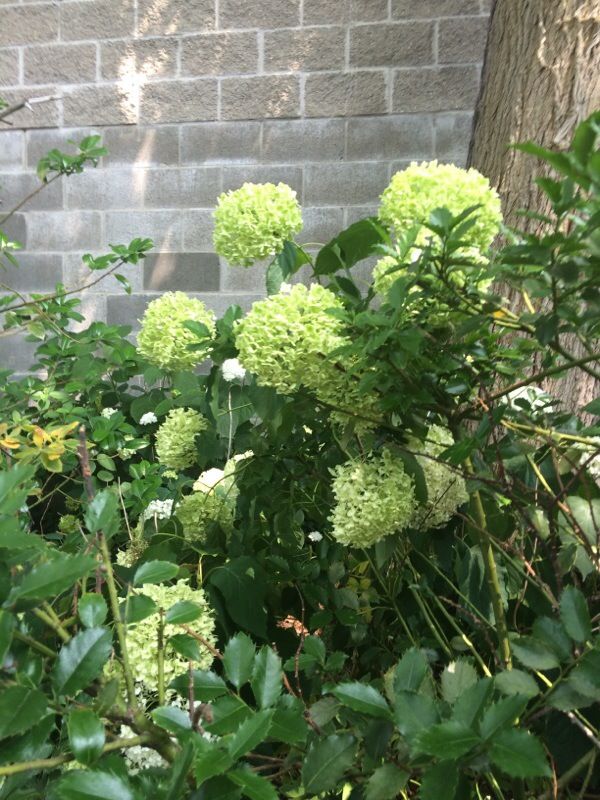 Hydrangea paniculata blooms Cotton Cream about 3.5 months from July.
Hydrangea paniculata blooms Cotton Cream about 3.5 months from July.
Juicy juniper green Green Carpet favorably sets off delicate hydrangea inflorescences. Such landings will look good both in a flower bed and as a hedge.
In addition to Green Carpet , other varieties of juniper are in perfect harmony with hydrangea. The composition will look completely different if, for example, instead of green juniper, you plant bushes with silver, golden or bluish needles.
Option 2. Hydrangea and Astilba
The second variant we offer consists of hydrangea and astilba. Thanks to the harmonious combination of shades and the contrast of shapes, it will be possible to create a bright and attractive corner in the garden. Astilbe feels good in such conditions that hydrangeas like, so the neighborhood will be a joy to her.
Hydrangea large-leaved Endless Summer (Endless Summer) is very popular in central Russia, because. able to endure harsh winters quite easily.
able to endure harsh winters quite easily.
Another advantage of this variety is its long flowering period, which lasts from early summer to September. This happens due to the fact that the flowers of the hydrangea Endless Summer appear both on the branches of the last year and on new shoots. For this feature, the variety got its name - Endless Summer . To encourage re-blooming, regularly remove wilted buds.
The height of the bush can reach 1.5 m. The shade of large spherical inflorescences can be corrected by changing the level of soil acidity. If you want them to turn pink, add some lime to the soil. However, this must be done in advance, either in late autumn or early spring.
Hydrangea's companion in this variant is Astilba sinensis Vision . This shade-tolerant plant looks great against the background of hydrangea, shading, but not closing it, because. astilba reaches a height of only 60-70 cm. The perennial blooms in July-August, throwing out vertical paniculate inflorescences of a rich pink or purple-red hue.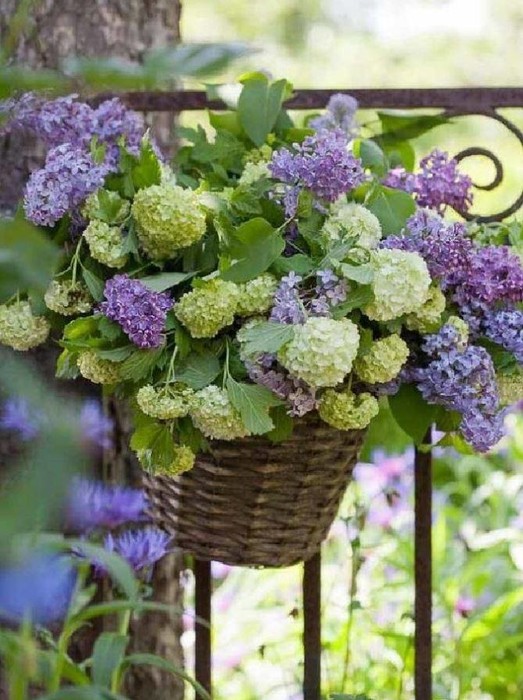
Astilbe remains attractive after flowering thanks to its foliage. Fern-like openwork branches are pleasing to the eye and look good against the background of rounded hydrangea leaves.
Option 3. Hydrangeas and ornamental grasses
If you want the hydrangea to be the main focus of the composition, plant ornamental grasses next to it. They will create a soft background and emphasize the beauty of the shrub. Most ornamental grasses do not require special care, so their cultivation will not cause difficulties.
The composition in option 3 is based on two varieties of large-leaved blue hydrangea - Endless Summer (Endless Summer) and Blaumeise . In the foreground is a low bush of golden ornamental hakonehloya grass. The contrasting combination of such dissimilar - both in color and foliage - plants will favorably emphasize the beauty of each of them.
Hydrangea Endless Summer has large - up to 20 cm in diameter - inflorescences, shaped like a ball.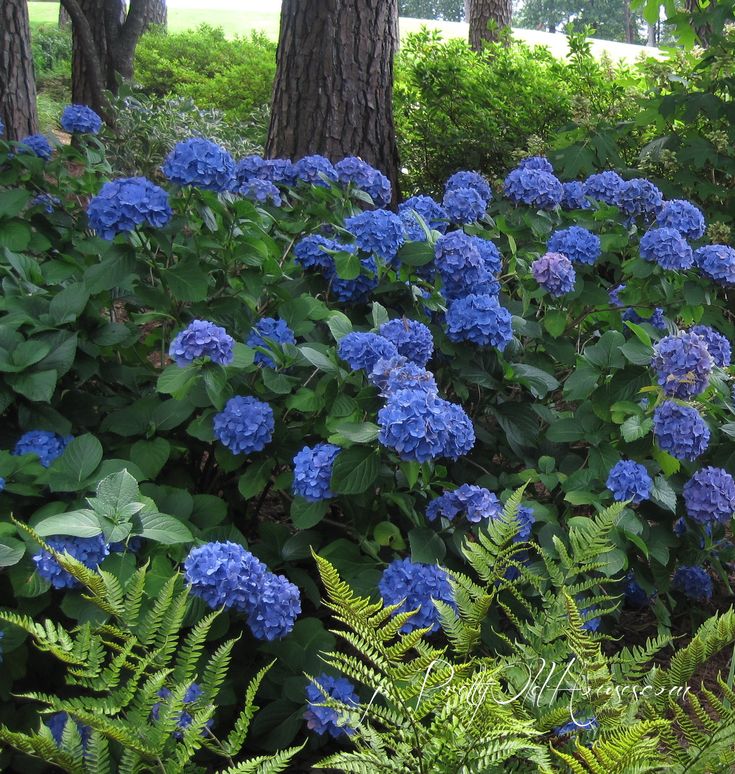 In height the bush reaches 1.5 m. They do not have a spherical, but a flat shape, and they consist of unequal flowers: in the middle of the inflorescence they are small, and along the edge on long legs there are spectacular large flowers of blue or bright blue. The diameter of the inflorescence is 20-25 cm. Flowering begins in mid-July and continues until September. The bush is compact, and the height and diameter are approximately the same - 90-130 cm. Depending on the acidity of the soil, the color of hydrangea flowers can vary: from purple-pink - on slightly alkaline soils to blue - on very acidic ones.
In height the bush reaches 1.5 m. They do not have a spherical, but a flat shape, and they consist of unequal flowers: in the middle of the inflorescence they are small, and along the edge on long legs there are spectacular large flowers of blue or bright blue. The diameter of the inflorescence is 20-25 cm. Flowering begins in mid-July and continues until September. The bush is compact, and the height and diameter are approximately the same - 90-130 cm. Depending on the acidity of the soil, the color of hydrangea flowers can vary: from purple-pink - on slightly alkaline soils to blue - on very acidic ones.
Hakonehloa (Hakonehloa, Hakone) is a perennial ornamental grass often also referred to as Japanese forest grass. Its graceful leaves come in various shades: golden, green, white. Often there is a green longitudinal stripe in the middle of the leaf blade. The plant reaches a height of 45 cm, the diameter of the bush is 60-75 cm. It grows slowly.
The stalks of hakonehloi initially stretch upwards, but over time, under the weight of the leaves, they bend and droop.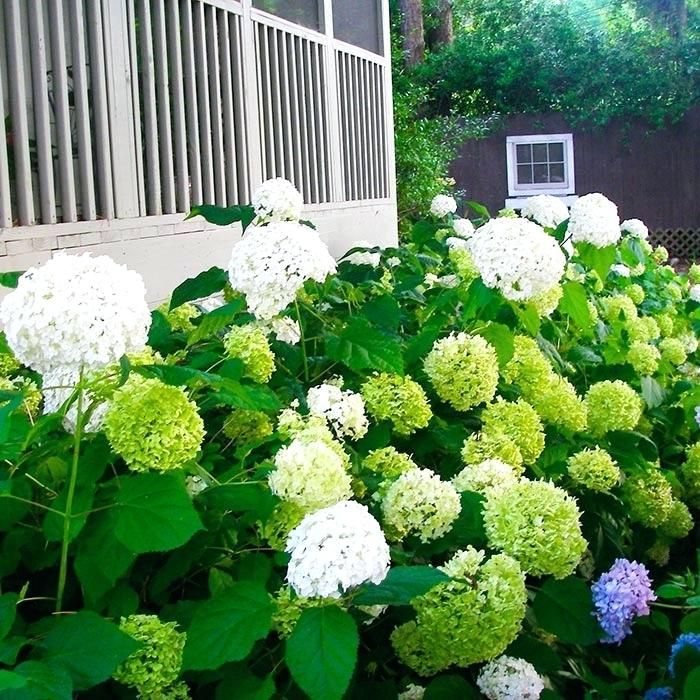 The curved leaves of the plant become like a cascade.
The curved leaves of the plant become like a cascade.
In addition to external beauty, Japanese forest grass has another advantage - it grows well in the shade. Therefore, option 4 is ideal for those who want to make a shady corner of the garden attractive: hydrangeas paired with hakone grass will help you with this.
Another option for planting hydrangea and Japanese forest grass together is in the photo below:
Option 4. Hydrangea and hostas
Speaking of the best plants that could be the company of hydrangeas, one cannot fail to mention the host. The drop-shaped leaves of this queen of the shady garden are in harmony with the leaf blades of most types of hydrangeas, and the expressive colors of the hosta, on the contrary, create a contrast with the calm greenery of the hydrangea. As for the growing conditions, here they have a complete match. Both plants prefer moist and fertile soil. Both feel great in the shade. Both hosta and hydrangea grow well in slightly acidic soil.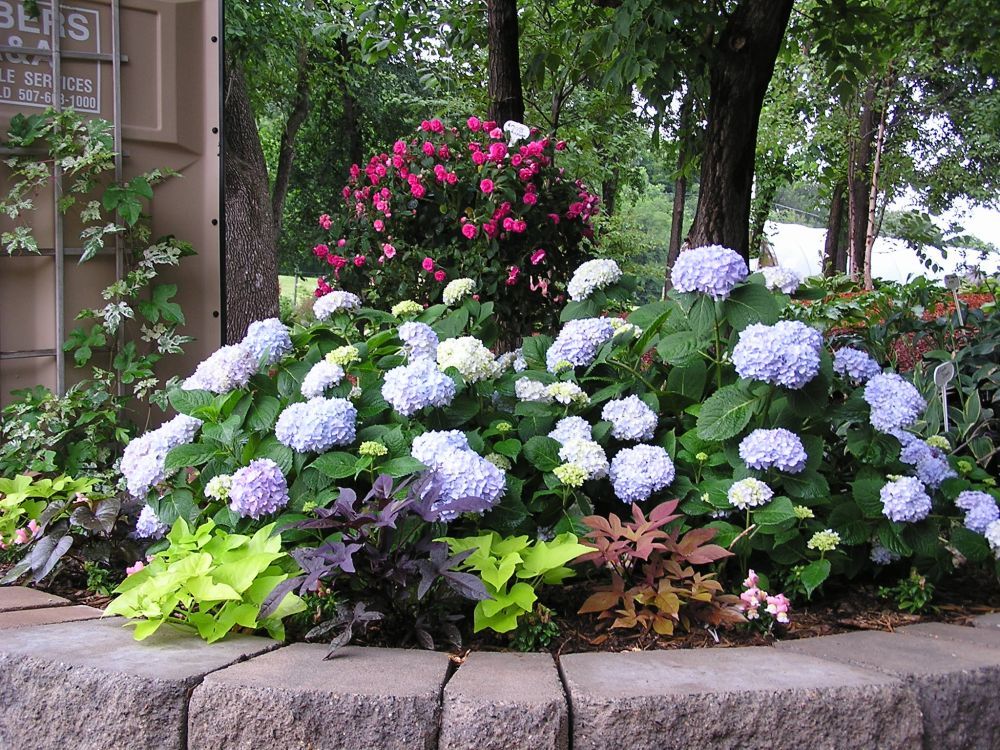 The fourth option, which we want to present to you, just consists of a pair of hydrangea plus a host.
The fourth option, which we want to present to you, just consists of a pair of hydrangea plus a host.
Large-leaved Hydrangea Madame Emile Mouillere has been decorating gardens for over 100 years. This is one of the best winter-hardy varieties of large-leaved hydrangea.
The bush grows in height from 1.2 to 1.8 m. It blooms both on the shoots of the last and the current year, so the flowering is long - from the end of July to September. However, even after flowering, hydrangea Madame Emile Mouillere does not lose its decorative effect. In autumn, its green foliage gradually changes color to orange or red.
The inflorescences of this variety are large, 15-20 cm in diameter, spherical in shape. The color of the flowers is white or pale pink. The edges of the petals are serrated.
Hydrangea Madame Emile Mouillere has one more advantage - it is almost not affected by diseases and pests.
Hosta Patriot is one of the most popular and favorite varieties of hostas for summer residents.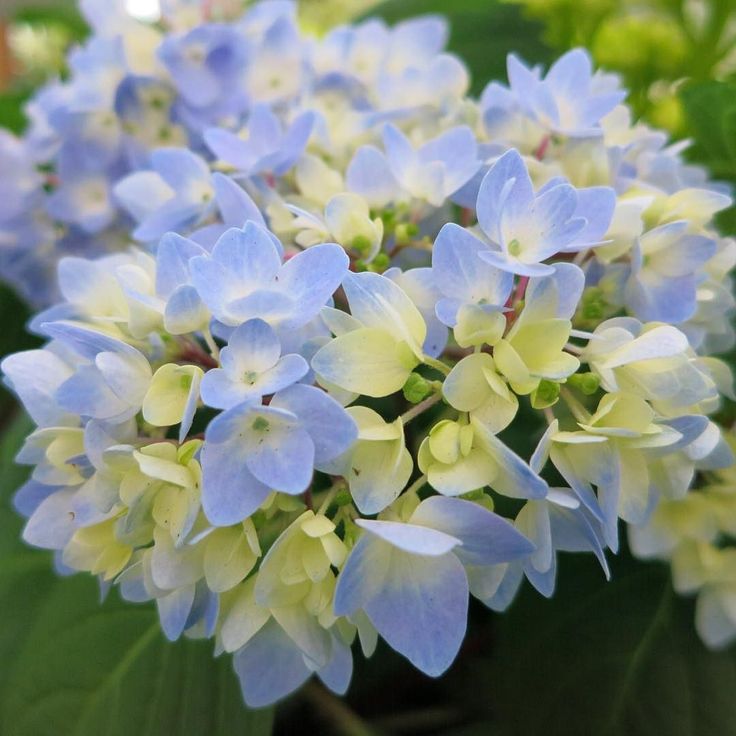 And not only, by the way, summer residents: in 1997, the American Association of Host Manufacturers called Patriot Host of the Year.
And not only, by the way, summer residents: in 1997, the American Association of Host Manufacturers called Patriot Host of the Year.
Large leaves of hosta Patriot have a dark green center and a wide white stripe along the edge. The flowers are blue or purple, appear on long stems in July-August. Plant height - 50-60 cm. Adult sprawling bush reaches a diameter of 60-70 cm.
The main danger that awaits the host Patriot - slugs and snails that eat the leaves of the plant.
This soft and elegant combination of large-leaved hydrangea Madame Emile Mouillere and hostas Patriot will brighten up your garden from summer to autumn without any difficulties in growing.
Option 5. Hydrangea and roses
One of the most beautiful combinations is hydrangea and roses. The queen of the shady garden next to the queen of flowers is, undoubtedly, not allies (as was the case in all previous versions), but competitors who are fighting for your attention, but at the same time they complement each other perfectly.